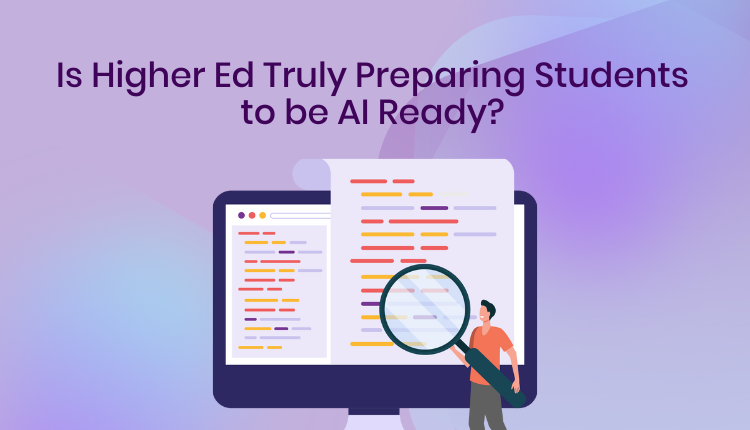Is Higher Education Truly Preparing Students for an AI-Driven Future?

In today’s job market, experience alone no longer guarantees a competitive edge. Employers are increasingly looking for graduates who can effectively collaborate with AI—those who can craft strategic prompts, assess AI-generated content, and make thoughtful, ethical decisions about its use. According to a 2024 Microsoft report, 71% of hiring managers would choose a candidate with AI capabilities over one with similar experience but no AI proficiency.
To meet this demand, graduates must be able to critically evaluate AI outputs, identify biases, improve generated responses, and ethically integrate these tools into their workflows.
Defining What It Means to Be AI Literate
Experts define AI literacy as a blend of three core skills:
-
Technical understanding – knowing how AI tools function and applying them effectively
-
Critical thinking – analyzing, refining, and improving AI outputs
-
Ethical reasoning – identifying bias, maintaining transparency, and acting responsibly
One model, the A-Factor framework developed by Ning et al. (2025), outlines 18 psychometric indicators across four domains: communication, creativity, content evaluation, and collaboration. Tested on over 500 individuals, this model offers a reliable way to gauge a student’s depth of AI competence, beyond just surface-level use.
The consensus is clear: real AI literacy is rooted in responsibility and reflection, not just tool usage.
Where Higher Ed Is Falling Behind
Despite AI’s expanding role in the workforce, many universities have yet to adapt effectively. Common institutional shortcomings include:
-
Banning AI in assessments, missing opportunities to promote critical thinking and ethical engagement
-
Restricting AI education to STEM programs, while overlooking its relevance in humanities, business, and the arts
-
Limited faculty support, leaving educators unprepared to teach or integrate AI into the classroom
Educators often feel overwhelmed by the rapid pace of AI development, resulting in inconsistent messaging to students. Some are penalized for using AI, while others are left to navigate it without guidance.
The Problem with Outdated AI Policies
For institutions to stay relevant, their AI policies must evolve. Without adaptation, they risk:
-
Harming student success, by missing key opportunities to teach AI proficiency
-
Reducing graduate readiness, as students may lack vital skills needed in AI-driven industries
-
Damaging their own reputation, by producing graduates unprepared for modern work environments
Colleges and universities need to continuously review and adapt their assessment strategies. Outdated or overly restrictive policies do little to support long-term goals. Instead, they should move toward enabling AI fluency, empowering both faculty and students to use AI tools as part of an ethical, skill-driven learning process.
What Universities Should Do Differently
Research from the Higher Education Policy Institute (HEPI) highlights important gaps:
-
Only 36% of students say their institution supports them in building AI skills
-
Nearly 31% report that their school bans or discourages AI use
A common faculty concern is that students will misuse AI to cut corners. But the real issue lies in how students use it and whether they’re being taught to engage with it critically and ethically.
To meet the needs of the future workplace, higher education must lead efforts to build true AI fluency. Tools like DocuMark can support this transition by fostering reflective, transparent, and responsible AI use instead of simply detecting and punishing misuse.
From Small Shifts to Institutional Transformation
AI is no longer confined to computer science labs, it’s now integral to how students learn, write, solve problems, and create. Whether they’re developing marketing content or synthesizing research, students interact with AI daily.
The critical question for universities isn’t whether students are using AI, it’s whether they’re being taught to use it well.
While students are rapidly adapting to this new norm, institutions are lagging behind. This isn’t just a tech gap, it’s a skills gap, and it threatens to leave a generation of graduates underprepared for the realities of an AI-first workforce.
We are entering a new era of literacy where understanding and applying AI is as fundamental as reading or writing. The institutions that will thrive are those that empower students to use AI ethically, creatively, and thoughtfully.
Tools like DocuMark play a vital role in this transformation. By asking students to document their AI prompts, explain their editing process, and reflect on how they used AI tools, DocuMark turns AI use into a learning moment—not a shortcut.
The real opportunity lies not just in teaching students how to use AI, but in shaping a generation of responsible, reflective AI users across every discipline.
Ready to Lead the Change?
The tools are available. The urgency is real. Now is the time for higher education to step up.
Schedule a demo to see how DocuMark integrates with your LMS, aligns with your academic policies, and helps foster a culture of ethical, AI-powered learning on your campus.




